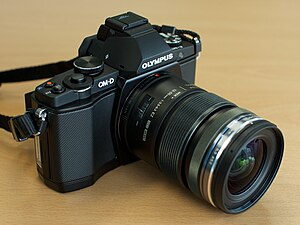Olympus OM-D E-M5
 | |
| Overview | |
|---|---|
| Type | Micro Four Thirds System |
| Lens | |
| Lens | Micro Four Thirds System mount |
| Sensor/medium | |
| Sensor | Four Thirds System 16MP Live MOS |
| Film speed | ISO 200–12800, extendable to 125-25600 |
| Storage media | SD, SDHC, SDXC |
| Focusing | |
| Focus modes | Automatic or Manual |
| Focus areas | 35 area selectable auto-focus |
| Exposure/metering | |
| Exposure modes | Manual, Program, Shutter Priority, Aperture Priority, User settings |
| Exposure metering | Intelligent Multiple |
| Flash | |
| Flash | Detachable and can trigger remote flash |
| Flash synchronization | up to 1/250s |
| Viewfinder | |
| Viewfinder | 1.44 million dot Epson Ultimicron LCD |
| Image processing | |
| White balance | Auto / Color temperature setting / Manual measurement |
| General | |
| LCD screen | VGA-equivalent 3in OLED touchscreen tilts upwards and downwards with live preview |
| Battery | Li-ion Battery Pack |
| Dimensions | 4.8 in × 3.5 in × 1.69 in (122 mm × 89 mm × 43 mm)[1] |
| Weight | 14.99 oz (425 g) with battery |
The Olympus OM-D E-M5, announced in February 2012, is a Micro Four Thirds compact mirrorless interchangeable lens camera. In style and name it references the Olympus OM series of film SLR cameras, but it is not an SLR camera (there is no optical path from lens to viewfinder: a high quality electronic viewfinder is used). The successor is the Olympus OM-D E-M5 Mark II.
Awards
In April 2012, the enthusiast photography web site Digital Photography Review (DP Review) awarded the OM-D EM-5 a Gold Award.[2] On the same website it was subsequently voted Best Camera of 2012 in a photographers' poll.[3]
Other photography news and reviews websites that awarded the OM-D EM-5 "Camera of the Year" for 2012 were photographyblog.com [4] and wirefresh.[5] The camera also won a 2012 Pop Photo award from the magazine Popular Photography.[6]
Features
- Magnesium alloy body with extensive weather sealing
- Up to ISO 25,600
- 16 MP Four Thirds sensor, with substantially lower noise than the earlier 12 MP sensor[2]
- HD video capture, including 1080i at 30 fps and 720p at 60 fps
- No built-in flash (a small shoe mounted flash is included, which can act as a wireless commander for E-system flashes which support wireless mode)
- TruePic VI processor
- 5-axis in-body image stabilisation
- Up to nine frames per second continuous shooting
- Very fast contrast detect auto focus[7]
- "Live Bulb" (without toggle) and "Live Time" (with toggle) bulb mode settings, where the viewfinder and display get updated 'during' the exposure in order to allow the photographer to inspect the exposure while it "develops". The display refresh rate for this mode can be configured between 0.5 s and 60 s.
- Tilting 800 x 600 LCD OLED touchscreen, allowing shooting from awkward angles and with the ability to select the focus point and release the shutter with a touch[8]
See also
References
- ^ "Olympus OM-D E-M5". Retrieved 19 May 2014.
- ^ a b "Olympus EM-5 In Depth Review - Conclusion". Retrieved 20 July 2012.
- ^ "Dpreview Users' Poll: Best Camera of 2012?". Dpreview. Retrieved 30 December 2014.
- ^ "Camera of the Year 2012". photographyblog.com. Retrieved 30 December 2014.
- ^ "Olympus OM-D E-M5 scoops up another Camera Of The Year award". wirefresh. Retrieved 30 December 2014.
- ^ "Best Gear Now". Popular Photography. Retrieved 30 December 2014.
- ^ "Olympus EM-5 In Depth Review - Performance (Speed and AF )". Retrieved 20 July 2012.
- ^ "The Olympus OM-D EM-5 Review - Creative Freedom". Retrieved 20 July 2012.
Further reading
Godden, Ed (Spring 2012). "Olympus OM-D". Practical Photography. Peterborough: Bauer. pp. 114–117. ISSN 0032-6445. OCLC 749128201.
